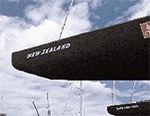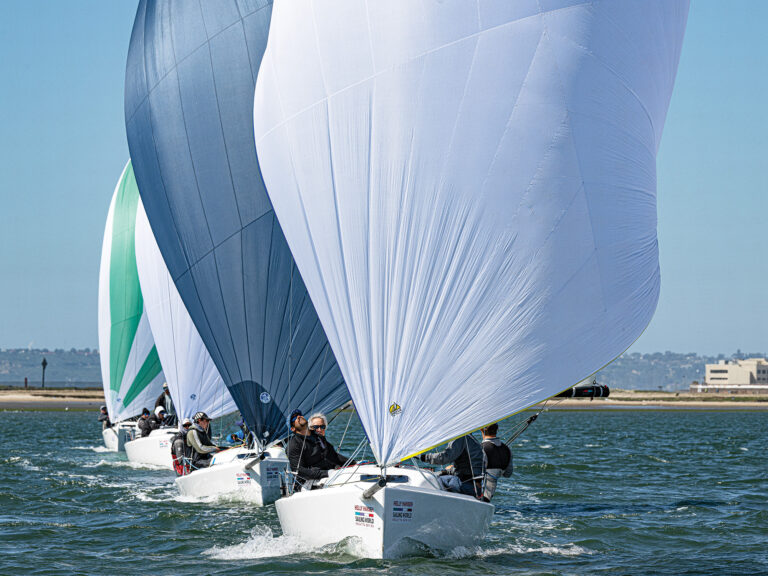
This article was originally published in Sailing World June 2000.
The Americas Cup once again bred exceptional achievements in sailing and design. Eleven challengers went through months of fierce and suspenseful racing in the Louis Vuitton series, from which Pradas Luna Rossa emerged as the fittest survivor. Yet, Team New Zealands nonstop design and testing program produced a higher order of the species.
The International Americas Cup Class was established in 1988 to create closely matched, athletically demanding contenders in the worlds largest class of racing yachts. Constraints within the rule force strong similarities yet leave room for winning differences. Team New Zealand found them. In light winds New Zealand was close enough to Luna Rossas low-speed slipperiness, but flew a deeper, more powerful mainsail that allowed quicker acceleration. As the breeze freshened, the versatile New Zealand sped away with superior sailing length, stability, and rig control.
Hulls: New Zealand’s hull was a little longer and beamier than Luna Rossa’s, adding wetted surface but gaining sailing length and stability. At the relatively fast speeds at which the highly powered IACC yachts sail, the largest drag component comes from making waves. Greater effective sailing length increases speed potential due to wavemaking, while greater displacement and beam increase wave drag. Consequently, the IACC Rule taxes length and credits displacement, with limits to keep them within bounds. However, rule biases have driven designs toward the upper limits of both. High speed favors length and, even at the Rule’s upper limit of 25 metric tons displacement, it’s better to have more stability from increased ballast than to save drag from being lighter.
Viscous drag increases with greater wetted surface area and, to a lesser degree, wider form. Although narrower beam has less drag, it also produces less righting moment. This years IACC yachts found a sweet spot at about 4 meters maximum beam. Luna Rossas design cut wetted surface by employing a narrower waterline beam than New Zealands but traded off some sail carrying power as a result.
Constraints imposed by the Rule and Mother Nature have led to similar looking hull shapes–except for the black boats. Hull sectional shape was generally not far from semicircular, the most efficient for wetted surface and reduced wavemaking drag. Because New Zealand was a little beamier, however, it was flatter across the hulls bottom.
All 11 challengers featured the characteristic “spoon” bow that has prevailed in this class, but New Zealands knuckled bow and more steeply rising forward overhang was a bold and successful departure. New Zealands bow exploited the way that rated length is taken at 200mm above the measurement waterline. New Zealand s steeper stem profile was designed so that a rated length equal to that of a conventional spoon bow provided a 200- to 300-mm longer effective sailing length.
In smooth water, the bow wave hardly grows forward of the static waterline, so the knuckled bow shape traded only slightly added drag to make a big gain in sailing length. Some loss of performance would be expected in rough water, but the Hauraki Gulf in late February is relatively tame. New Zealands bow wasnt pretty, but it crossed the finish line first every time.
Team New Zealands attention to detail is also seen in the after overhangs flat underside. Appearing to have been carved by a cheese slicer, it shortened rated length farther. The last two Americas Cup winning 12-Meters, Australia II and Stars & Stripes 87, used the same trick under a similar rule for rated length, but New Zealand was the first to try it in this class.
Keels: Although Luna Rossa and New Zealand s keel fins had some differences, their bulbs and winglets varied more noticeably. An IACC yachts lead ballast bulb carries about 75 percent of the yachts total weight at the tip of an amazingly small fin. New Zealand traded off increased wetted surface in its bulb for extra stability; its a little longer and more slender than Luna Rossas but with a lower center of gravity. Luna Rossas bulb not only had less wetted surface in its shorter, thicker form, but also placed its maximum thickness just aft of the keel fin, apparently tailored with deliberate effort to further reduce drag. It may have had less drag downwind, but its upwind performance was compromised by its higher center of gravity.
Luna Rossa’s winglets were tail-mounted–the choice of most IACC design programs. New Zealand’s, to the contrary, were located just aft of the keel fin. The performance differences between the two locations are probably small, but the successful defender defied the rest of the world’s consensus about this detail.
Rigs: New Zealand’s rig made gains in windage reduction and permitted greater power from the mainsail. To control sail power over the Hauraki Gulf’s wide range of wind conditions, the challengers developed stiffer masts to fly flatter mains. Meanwhile, Team New Zealand continued its forward thinking in mast and sail development with an innovative mast and staying system. The upper ends of the diagonal shrouds connect to the opposite spreader tips and intersect the mast in a crisscross arrangement. Diagonal shroud loads are halved, with corresponding reductions in weight and windage.
New Zealands mast tube was significantly longer fore-and-aft than the Rule minimum, adding to effective mainsail area. Tube breadth could be increased correspondingly with negligible added drag. Better tube stiffness and support allowed dropping the number of spreaders from four to three, further reducing weight and windage. To meet the Rules minimum mast weight, more carbon could be built into the tube itself for better inherent stiffness.
New Zealand was able to fly a fuller, more powerful mainsail because of its beamier hull, lower bulb VCG, and stiff, crisscross rig. In light air this helped overcome perhaps a little greater hull and appendage drag. Then, with its longer sailing length it footed fast but could point when necessary. Through superior sails, stability, keel efficiency, and crew work, it accelerated faster out of tacks. Although Luna Rossa showed competitive speed downwind, it could not match New Zealands remarkable performance in all conditions upwind.
Sailors: In 1995 skipper Russell Coutts remarked that “a little boatspeed can make you look famous.” This year Coutts made every effort to showcase the depth of a team thats set new standards in performance development and boat handling. Teamwork like theirs makes designers look famous.
Naval Architect David Pedrick has designed eight Americas Cup contenders including Courageous (74) and Stars & Stripes (87).









